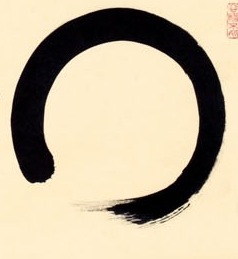The guiding principle in Zen practice and its expression in art is: “Simple is best.” The best expression of Zen brushwork is the simplest form possible—a circle. Interpretation of the Zen circle, the enso, can be complex, profound, even convoluted. Or it does not have to be explained at all, only contemplated. Creation of an enso is a reflection of one’s mind—good or bad. Seemingly so easy, the production of a genuine enso—brought into being without ego, with no-mind, and deep realization— is exceedingly difficult.
A single brushstroke can magically bring Daruma, the Grand Patriarch of Zen, to life. In the gallery, we have a one-stroke Daruma by Nantembo. It depicts Daruma from behind, turning his back on the world, sitting like a rock in his cave, to face the wall in deep meditation. A figure created out of one simple brushstroke tells a complex story: in Zen practice one needs to spend time in quiet seclusion, away from the bustling world; physical requirements must be minimal; days are spent in mediation facing a seemingly impenetrable wall, symbolic of all the barriers that one must break through on the way to enlightenment. But “nine-years of wall-gazing” is only the beginning. One needs to leave the cave, face the world, and practice Zen in the marketplace.
While a single stroke enso can mean emptiness, a single stroke Daruma represents the opposite, rock solid form. In Zen, we need both.

